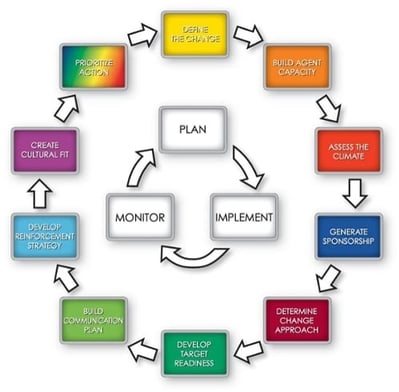If there’s one thing we know for sure, in today’s business world change is everywhere. This endless state of transition causes everyone we know, everywhere we go to be whirling around like crazy. Keyboards are clicking, phones are ringing, meetings are being held (most with “hard stops” because each person has to get to their next meeting). It’s this constant churn of activity that makes an organization seem like it is running and humming like a well-oiled machine.
But, have you ever stopped to ask what exactly everyone is doing? Are they just spinning their wheels with activity or are they making an actual impact with their actions?
As experts in the change management field, we are firm believers that impact is far more important than activity. It sounds sort of obvious when we say it out loud, but you’d be surprised at the number of companies who think just because they are busy, change management is happening. The simple truth of the matter is it’s not about being busy; it's about focusing on the right actions at the right time.
What is the Cause of this Craziness?
Ideas and innovation are what keep organizations one step ahead of their competitors. But, one turn of the strategic initiative wheel at the top of the executive pyramid often creates constant spinning of the change wheel further down the organization. 
To illustrate this point, think of your senior executive Sponsors as the "big wheel" at the top. Each time the senior leaders launch a new strategy from up high, their personal change wheel may move just a notch. But the "little wheels" of the organization start churning as the disruption and impacts of the change are felt, much like little hamsters madly turning the wheel.
Meanwhile, the senior leaders have moved on to the next change, without appreciating that the past changes are still being absorbed lower down the organizational food chain. It’s the reason so many of us are dealing with change saturation. There are just far too many changes, chasing too few resources.
Let Change Management Guide Your Actions
We often get asked, “what can be done?” In simple terms, you need to use a change management process that guides you on what to be doing, rather than “doing change management.” The goal of change management should never be "to do" a process, but instead to have core principles guide you on what you should be doing, given the day-to-day realities and challenges of the project. 
Yes, your change framework should be a repeatable process, but it also needs to be one where you don't have to apply every step, every time. Some judgment should always be involved in determining which strategies and tactics are needed, when.
That’s why our proprietary Accelerating Implementation Methodology (AIM) was designed to be used in any situation in a “fit for purpose way.” The 10 core principles depicted in the AIM Road Map are meant to guide you on what is needed to have the most amount of impact, using the least amount of resources possible.
What Change Agents Should be Doing
So, where should your Change Agents focus their attention? One thing we can tell you for sure is that tools and templates are not the answer. Tools are just that, tools. And Change Agents can't be effective if they are simply guided by completing checklists and templates instead of being led by core principles.
Instead, Change Agents should be out in the organization managing the implementation by using the directional guidance the core elements of AIM provide. Some of these elements include:
- Defining the Change – A clear, compelling definition of the change should always be the starting point of every change initiative
- Generating Sponsorship – Ensuring you have active and committed Sponsorship is the single most critical success factor in a fast and successful implementation of any type of business change
- Developing a Reinforcement Strategy – Reinforcement is your organization’s power lever to get people to change their behavior
- Building a Communication Plan – Communication efforts should be centered around delivering the right message to the right audience and should always include a feedback loop
- Building Target Readiness – Building Readiness now will help reduce resistance later
What Sponsors Should be Doing
While Change Agents are out in the organization managing the hard work of implementation, Sponsors (defined as anyone who has direct reports impacted by the change) have their own set of actions that are needed for a successful change. Sponsors must:
- Express commitment to the change by what they say publicly and privately
- Model commitment to the new behaviors by the resources they allocate and the decisions they make
- Reinforce the new behaviors by applying rewards and consequences as behaviors are observed on a daily basis
It is this cascade of active Sponsors at every level of the organization, each of whom is Expressing, Modeling and Reinforcing their public and private commitment to the change that is the single most critical success factor in ensuring a fast and successful implementation.
Take a look around your organization. What are your Change Agents doing? How about your Sponsors? If the constant whoosh of activity you see is mostly low-yield, spinning of wheels it may be time to take a look at your change management methodology. Is it activity based or impact based? You be the judge.


